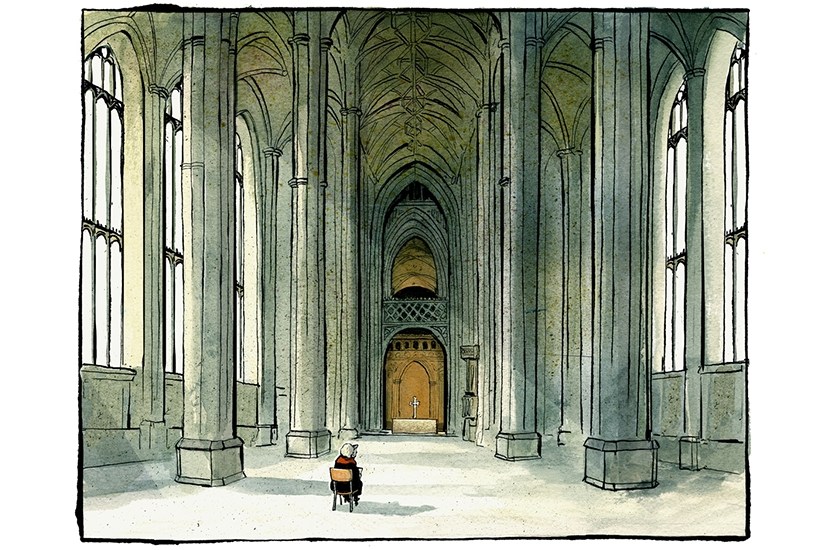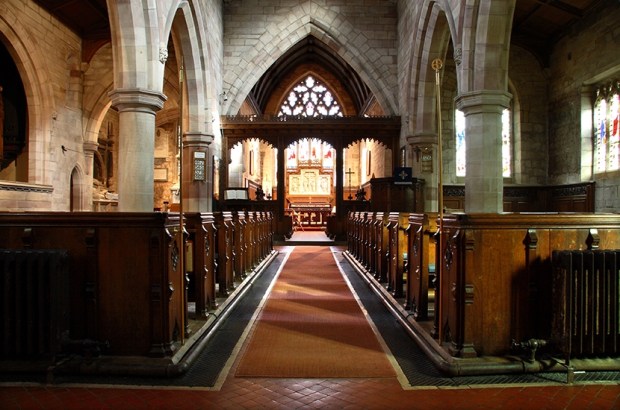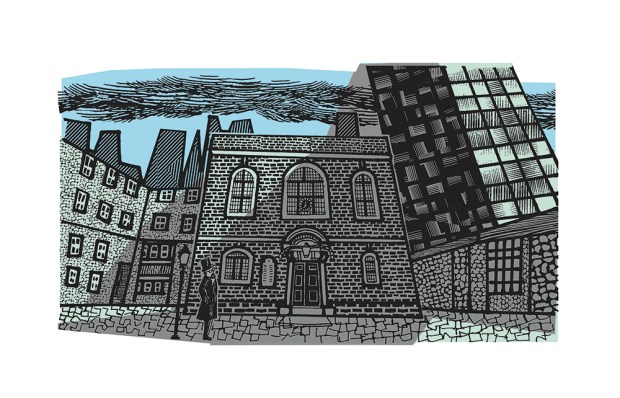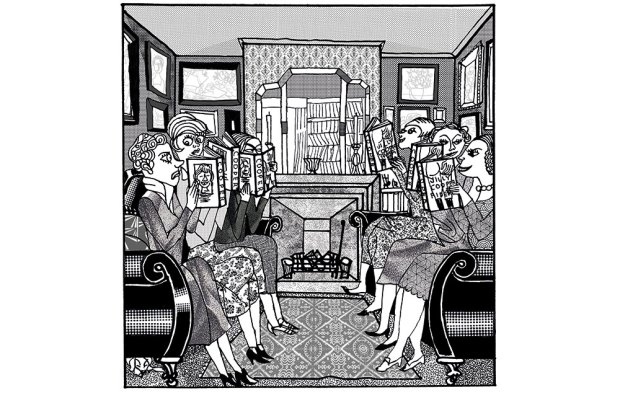I am a key limiting factor. That’s a new one for a clergyman of the Church of England. We’ve traded under parson, cleric, priest, minister, padre and even pie-and-liquor, but never before have I heard us described as ‘key limiting factors’.
That this phrase was used during the announcement of a new official C of E scheme — to create 10,000 new lay-led churches in the next ten years — adds future injury to present insult. ‘Lay-led churches release the Church from key limiting factors,’ said Canon John McGinley introducing the initiative. ‘When you don’t need a building and a stipend and long, costly college-based training for every leader of church… then actually we can release new people to lead and new churches to form.’ Well, maybe. But once you’ve ditched the buildings, the clergy and theological education, you don’t have very much of a church left.
On one level, this ‘key limiting factor’ business is rather amusing. It was only in February that the Archbishops of Canterbury and York took to these pages to accuse those of us concerned for the future of the parish system of being ‘rascally voices’. The articles Emma Thompson and I wrote for The Spectator were denounced as scare-mongering. Five short months (and one Freudian slip) later, and we are all rascals now.
On another level it’s just rude. We clergy might be ‘limiting factors’ to growth, but we are the ones who have been plugging our way through the hell of this pandemic, keeping food banks open, hospital chaplaincies staffed, lonely old (and young) people telephoned. We’ve had to learn how to put services on YouTube, hold prayer meetings on Zoom and minister to devastated families in desolate funerals of six while those much-maligned old churches became the focus of a fervent public desire to have them be open.
And thank God for our theological training. Where is God in a pandemic? That’s the question so many have asked me since last year, and I could only stumble towards an answer because long ago I had studied the theology of the Cross and the book of Job.
This plan isn’t just rude, it’s dangerous. Ten thousand new lay-led churches, ‘20 or 30 people meeting in a home’, which will bring in a million new members. Where to start with this? Perhaps we should start with the sacraments, because 10,000 lay-led churches without all those expensive priests to celebrate communion starts to raise the question of what we mean by ‘church’.
Let’s also ask where we are going to find 10,000 people rich enough to be able, without any pay, to devote the vast amount of time needed to lead a church (with all the pastoral responsibilities, safeguarding duties and person management which I promise will be necessary with or without the ‘key limiting factor’ of an actual church building). Then we’re going to need to make sure they have a house big enough to host 20 or 30 people for acts of worship (which, I suppose, takes us back to finding 10,000 people with private means). Then, being entirely reliant upon 10,000 for their time, money, and palatial residence, are we quite sure we want to place them in pastoral oversight of one million brand-new Christians without any of that costly, limiting theological and pastoral education?
At the absolute best, this is going to be the biggest exercise in displacement activity in the history of the church. There are currently 12,500 parishes in the C of E, which have taken 1,500 years to develop organically. We are talking about almost doubling that number in ten years. That’s three a day. If we take this seriously, every sinew of the organisational structure of the church will be dedicated to nothing else for a decade.
That’s the best-case scenario. The worst takes us back five months to The Spectator’s ‘rascally’ cover piece. The trigger for concern then was a leak to the Sunday Times of an internal church document of how to respond to the pandemic. It included this smoking gun: ‘Many diocesan leaders believe that the financial challenges being exposed by the pandemic mean this is the moment to embark on radical changes to reshape existing resource patterns and ministry structures.’ In the panic following the leak, the Archbishops gave a number of assurances, in which a certain sleight of hand could be discerned. The first was the denial of any national strategy. This is either negligent to a terrifying degree or totally disingenuous. The 2016 decision to move from the ‘Darlow formula’, which subsidised poorer dioceses, to ‘Strategic Development Funding’, which could only be spent on new projects, was a national strategy. The consequences were local, for example Chelmsford diocese being forced to cull 60 clergy (one fifth of their total), but the claim this was all down to local decision-making is just untrue.
The consequence is also that all over the country dioceses are desperately trying to create exciting projects and sexy management roles to attract SDF grants rather than support their existing parishes. If you’ve wondered why we are suddenly flooded by ‘Associate Archdeacons’, full-time area deans and ‘Directors of Justice, Peace and Integrity of Creation’ (yes, really), it’s because these can be funded from the magic pot of money while boring, snoring parishes with their boring, snoring local ministry cannot.
There is a national choice being made every time the terms are set for how funding is disbursed. And the decisions are clear for people who are able to wade through the Church’s management-speak. The latest piece of jargon is that we must become a ‘mixed ecology church’, where the traditional parish is to sit alongside these exciting new projects. Who could object to that? It sounds so delightfully middle-of-the-road Anglican. But it isn’t. It’s taking the traditional Anglican model and forcing it to share space with a totally new way of being Anglican, one drafted in from nonconformity: without the priesthood, the buildings or the theological education for which Anglicanism has always been known. And this sharing, far from being a benign borrowing of ideas from sister churches, will inevitably become a battle over resources.
This isn’t suggesting that all parishes are going to be shut down: of course they aren’t. This isn’t suggesting the total number of clergy will be cut: some are certainly being made redundant, but overall the money will be repurposed. What this does suggest is that the entire nature of the Church of England is being refashioned, and it is time this refashioning gets proper debate.
This is your church. This is not the Archbishop of Canterbury’s, nor the House of Bishops’s, nor the clergy’s, not even the General Synod’s. It belongs, in a broad sense, to the people of England (regardless of your faith or lack of it — which is why parliament is still its ultimate decision-making body) and very specifically to the laity of the Church of England. You have a say.
There are about to be General Synod elections. So, stand. Stand and write in your manifesto that you are standing to ‘Save the parish’. Stand whether you are an Evangelical or an Anglo-Catholic or a High Churchman. Stand if you’re a female priest or a woman who doesn’t think women can be priests. Stand if you want to save the parish, because these are your parishes and this is the only important question for the next five years. Stand because this might really be the last chance to save the church we love.
And if we’re going to promise to ‘Save the parish’, let’s use those ‘limiting factors’ as our banners: ‘a building and a stipend and long, costly college-based training for every leader of the church’. That sounds like an ambition worth having — and a more plausible and desirable one than 10,000 mansion churches led by the untrained super-rich. Let us be a ‘key limiting factor’, not to the growth of the Church of England but to the emergence of a church we do not want and we do not need.
Got something to add? Join the discussion and comment below.
Get 10 issues for just $10
Subscribe to The Spectator Australia today for the next 10 magazine issues, plus full online access, for just $10.
You might disagree with half of it, but you’ll enjoy reading all of it. Try your first month for free, then just $2 a week for the remainder of your first year.














Comments
Don't miss out
Join the conversation with other Spectator Australia readers. Subscribe to leave a comment.
SUBSCRIBEAlready a subscriber? Log in